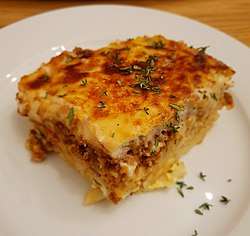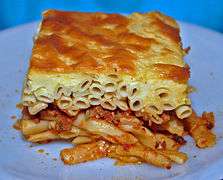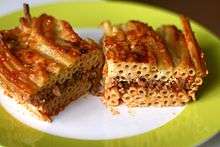Pastitsio
Pastitsio (Greek: παστίτσιο, pastítsio), sometimes spelled pastichio, is a baked pasta dish with ground meat and béchamel sauce found in Greek, Egyptian, Maltese and Cypriot cuisines.
 | |
| Course | Pasta |
|---|---|
| Place of origin | Greece |
| Main ingredients | ground beef, béchamel sauce |
Name and origin

Pastitsio takes its name from the Italian pasticcio, a large family of baked savory pies which may be based on meat, fish, or pasta.[1] Many Italian versions include a pastry crust; some include béchamel.[2] The word pasticcio comes from the vulgar Latin word pastīcium[3] derived from pasta, and means "pie", and has developed the figurative meanings of "a mess", "a tough situation", or a pastiche.[4]
In Cyprus and Turkey, it is called "oven macaroni" (Greek: μακαρόνια του φούρνου, makarónia tou foúrnou, Turkish: fırında makarna).[5][6][7][8]
In Egypt, it is called macarona béchamel (Egyptian Arabic: مكرونة بشاميل [mɑkɑˈɾoːnɑ bæʃæˈmel, -be-]).
Greece

The most popular current form of pastitsio in Greece was invented by Tselementes. Before him, pastitsio had a filling of pasta, liver, meat, eggs, and cheese, did not include béchamel, and was wrapped in filo, similar to the most Italian pasticcio recipes, which were wrapped in pastry: "he completely changed the dish and made it a kind of au gratin".[9]
The Tselementes version—which is now ubiquitous[9]—has a bottom layer that is bucatini or other tubular pasta, with cheese and/or egg as a binder; a middle layer of ground beef, or a mix of ground beef and ground pork with tomato sauce, cinnamon and cloves. Other spices like nutmeg or allspice are used in the top layer that is a béchamel or a mornay sauce. Grated goat cheese is often sprinkled on top. Pastitsio is a common dish, and is often served as a main course, with a salad.
Cyprus
In Cyprus, it is an essential dish during weddings and celebrations such as Easter, where it is served along with spit roasted meat. Recipes vary, but usually the meat sauce in the middle is made of pork, beef or lamb, tomatoes are only sometimes used, and it is flavoured with mint, parsley or cinnamon. The top is sprinkled with grated halloumi or anari cheese, though cheese is sometimes added only to the white sauce.[5][10]
A Turkish Cypriot version of this recipe (Turkish: bol peynirli makarna fırında) two types of cheese, kaşar peyniri and beyaz peyniri, for the meat.[11]
Egypt
The Egyptian version is typically made with penne or macaroni pasta, minced meat with minced onion, tomato sauce, and béchamel sauce, sometimes with egg or cheese on top.[12]
Malta
In Malta, timpana (the name probably derived from timballo) is made by tossing parboiled macaroni in a tomato sauce containing a small amount of minced beef or corned beef, bound with a mixture of raw egg and grated cheese. Hard-boiled eggs are sometimes added. The macaroni is then enclosed in a pastry case or lid before being baked.[13][14] A similar dish without the pastry casing is imqarrun.
References
- Accademia Italiana della Cucina, La Cucina: The Regional Cooking of Italy, pp. 310–313
- Vincenzo Buonassisi gives 41 kinds in Il Nuovo Codice della Pasta, Rizzoli 1985; see also Touring Club Italiano, Guida all'Italia Gastronomica, 1984.
- "Pasticcio". Vocabolario della lingua italiana. Treccani. Retrieved 5 March 2014.
- Oxford Paravia Italian Dictionary, 2001, ISBN 0-19-860437-8
- "Μακαρόνια του φούρνου". foodmuseum.cs.ucy.ac.cy (in Greek). Cyprus Food Virtual Museum. Retrieved 26 November 2015.
- "Chef´s Choice – Cypriot Recipes – Baked Macaroni (Pastitsio / Fırında Makarna)". Retrieved 16 December 2018.
- "Traditional Dishes of Cyprus" (PDF). Cyprus Ministry of Agriculture Natural Resources and Environment. Retrieved 16 December 2018.
- "KIBRIS USULÜ FIRINDA MAKARNA" (in Turkish). Kıbrıs Ortam. Retrieved 16 December 2018.
- Aglaia Kremezi, "Nikolas Tselementes", Cooks and Other People, Proceedings of the Oxford Symposium on Food and Cookery, p. 168
- Greek Mediterranean Cuisine
- "Bol Peynirli Fırın Makarna" (in Turkish). Mynet Yemek. Retrieved 16 December 2018.
- McWilliams, Mark (7 May 2016). Food and Communication: Proceedings of the Oxford Symposium on Food and Cookery 2015. Oxford Symposium. ISBN 9781909248496 – via Google Books.
- Sheehan, Sean (2000). Malta. Marshall Cavendish. p. 120. ISBN 9780761409939 – via Google Books.
- "Maltese Timpana". SBS Food. Retrieved 2019-10-29.
Sources
- Babiniotis, Georgios (2005). Λεξικό της Νέας Ελληνικής Γλώσσας. Athens: Κέντρο Λεξικολογίας.